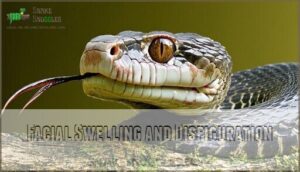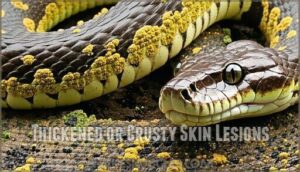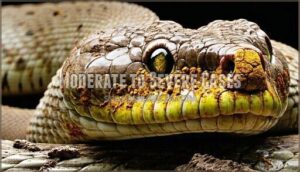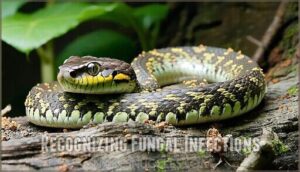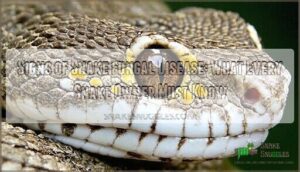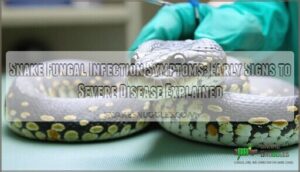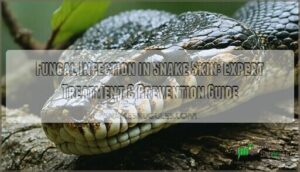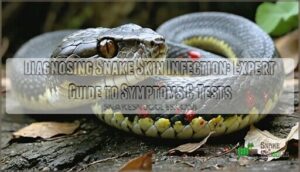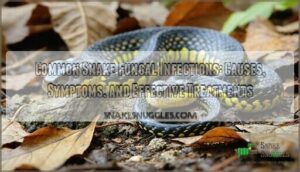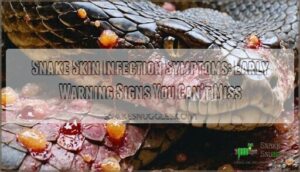This site is supported by our readers. We may earn a commission, at no cost to you, if you purchase through links.
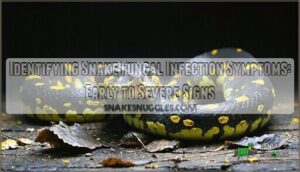 When identifying snake fungal infection symptoms, you’ll first notice yellow-brown scabs forming crusty patches on your snake’s scales, often accompanied by unusual shedding where old skin won’t release properly.
When identifying snake fungal infection symptoms, you’ll first notice yellow-brown scabs forming crusty patches on your snake’s scales, often accompanied by unusual shedding where old skin won’t release properly.
Watch for cloudy eyes with facial swelling, decreased appetite, and lethargy – these behavioral shifts signal trouble brewing beneath the surface.
Advanced cases develop thickened, ulcerated lesions, respiratory wheezing, and pronounced weight loss that can prove fatal without intervention.
PCR testing provides 98% accuracy in detecting the Ophidiomyces ophidiicola pathogen, while histopathology confirms fungal presence in tissue samples.
The progression from minor scabs to systemic organ damage happens faster than most owners expect.
Table Of Contents
- Key Takeaways
- Snake Fungal Disease Signs
- Identifying Infection Symptoms
- Clinical Signs and Diagnosis
- Symptoms and Disease Stages
- Recognizing Fungal Infections
- Frequently Asked Questions (FAQs)
- Can snake fungal disease be cured?
- How contagious is snake fungal disease?
- What does a skin infection look like on a snake?
- How do you know if a snake has fungal disease?
- How do you know if a snake is infected?
- What happens if a snake gets fungus?
- What is snake fungal disease?
- How does snake fungal identification work?
- What does snake fungal disease look like?
- How is snake fungal disease diagnosed?
- Conclusion
Key Takeaways
- Watch for yellow-brown scabs and crusty patches on your snake’s scales – these telltale lesions often appear first and signal the infection’s early stages when treatment works best.
- Notice unusual shedding patterns and cloudy eyes alongside behavioral changes like decreased appetite and lethargy – these symptoms indicate the disease is progressing beyond surface-level skin problems.
- Seek PCR testing for accurate diagnosis when you spot visual symptoms – this laboratory method detects Ophidiomyces ophiodiicola with 98% accuracy and confirms what you’re seeing.
- Act quickly before respiratory distress develops – advanced cases show thickened ulcerated lesions, wheezing sounds, and severe weight loss that can prove fatal without immediate veterinary intervention.
Snake Fungal Disease Signs
You can spot snake fungal disease by watching for key warning signs that appear on your snake’s skin and behavior.
These symptoms range from mild skin changes to severe disfigurement that can threaten your snake’s survival.
Scabs and Lesions
Scabs and lesions represent the telltale signs of skin infection in affected snakes.
You’ll notice crusty scabs forming yellow to brown crusts on scales, often with dark pigmentation changes. These fungal lesions create thickened, irregular patches that damage normal scale structure.
Look for yellow-brown crusts and thickened scales—these telltale signs signal serious fungal infection
Scale damage becomes obvious as lesion treatment requires identifying these crusty formations early for effective intervention, which involves recognizing telltale signs and understanding the importance of early intervention.
Unusual Molting Patterns
Recognizing when your snake isn’t shedding properly can save its life.
Snake fungal infection symptoms often disrupt the natural molting process, creating telltale warning signs you shouldn’t ignore.
| Normal Molting | Infected Molting | Action Needed |
|---|---|---|
| Complete shed removal | Retained skin patches | Veterinary exam |
| Regular timing | Frequent attempts | Monitor closely |
| Clean separation | Difficulty shedding | Immediate care |
Watch for ecdysis difficulties and scale damage that signal trouble brewing beneath the surface.
Cloudy or Opaque Eyes
You’ll notice cloudy or opaque eyes developing alongside facial swelling as snake fungal infection symptoms progress.
This ocular damage stems from inflammation around the eye socket, creating a milky appearance that signals vision loss.
Eye discharge may accompany the cloudiness, indicating deeper fungal invasion.
Snake skin lesions extending toward facial areas often precede these fungal infection signs, making early detection essential for preventing blindness.
Behavioral Changes
Beyond visual symptoms, infected snakes display distinctive behavioral changes that signal disease progression.
You’ll notice your snake becoming less active, showing reduced feeding responses, or exhibiting unusual aggression patterns.
Watch for these key Lethargy Signs:
- Decreased activity levels – Snake remains motionless for extended periods
- Feeding issues – Loss of appetite leading to significant weight loss
- Social withdrawal – Avoiding normal basking or hiding behaviors
- Respiratory problems – Wheezing sounds indicating systemic infection
These stress factors compound the infection’s impact, creating a cycle where behavioral changes worsen the underlying condition.
Identifying Infection Symptoms
When you’re evaluating a snake for fungal infection, you’ll need to look beyond surface-level symptoms to identify the full spectrum of clinical signs.
Advanced symptoms often signal that the disease has progressed substantially, requiring immediate veterinary attention and more intensive treatment protocols, which is a clear indication that the infection has become advanced.
Skin Ulcers and Nodules
Among the most telling indicators of snake fungal disease, skin ulcers and nodules serve as critical diagnostic markers you’ll encounter during assessment.
Watch for yellow-brown crusty lesions and nodules—these critical markers signal serious fungal invasion requiring immediate veterinary attention
| Lesion Type | Key Characteristics |
|---|---|
| Ulcers | Open wounds with tissue loss, often at scale margins |
| Nodules | Raised subcutaneous lumps containing fungal material |
| Blisters | Fluid-filled vesicles forming before molting cycles |
Nodule formation typically begins as swollen scales that progress into hardened, yellowish crusts.
Ulcer severity correlates directly with fungal loads detected through PCR testing.
Skin necrosis develops when subcutaneous lumps penetrate deeper tissues, creating granulomas.
Lesion development follows predictable patterns, starting at scale edges before coalescing into larger affected areas.
The disease is caused by Ophidiomyces ophidiicola.
Facial Swelling and Disfiguration
You’ll notice Head Swelling progressing from simple skin lesions to serious facial disfigurement that can threaten your snake’s survival.
Fungal infection signs include pronounced swelling around the snout and head region, creating visible facial deformity.
This disfigurement often interferes with feeding behaviors, while eye damage from orbital swelling can impair vision and hunting ability completely.
Respiratory Issues and Wheezing
While facial swelling progresses, you’ll notice respiratory distress developing in affected snakes.
Breathing difficulty emerges as Pulmonary Involvement worsens, with wheezing sounds becoming audible during respiration.
Nasal Discharge often accompanies these clinical signs, indicating secondary infections have taken hold.
Snake fungal disease symptoms include abnormal breathing patterns that signal potential Lung Damage from fungal spread throughout respiratory tissues, which can lead to severe respiratory distress.
Thickened or Crusty Skin Lesions
Thickened or crusty skin lesions represent one of the most recognizable signs of snake fungal disease symptoms.
You’ll notice these areas appear as yellow to brown crusty scales with distinct thickening patterns.
The fungal infection causes scale damage that creates characteristic scabbed textures along the snake’s body.
These skin lesions often show erosion around scale margins, making lesion treatment challenging once established, due to the scale damage.
Clinical Signs and Diagnosis
You can accurately identify snake fungal disease through specific clinical signs combined with proper laboratory testing.
Professional diagnosis requires PCR analysis and histopathology to confirm the presence of Ophidiomyces ophiodiicola in affected tissue samples, which is a crucial step for an accurate diagnosis.
Laboratory Tests and PCR
When dealing with suspected snake fungal infections, you’ll need precise lab diagnosis through molecular testing and PCR methods.
These diagnostic tools detect fungal DNA with remarkable accuracy, helping veterinarians confirm infections before starting antifungal treatment.
- PCR Methods: Quantitative PCR detects Ophidiomyces ophidiicola DNA with 98% sensitivity in confirmed cases
- Sample Collection: Lesion swabs yield higher PCR positivity rates than unaffected skin areas
- Molecular Testing: Real-time PCR assays target specific genetic regions, avoiding cross-reactions with related fungi
Accurate diagnosis of snake diseases also relies on understanding snake lung parasites to develop effective treatment plans.
Histopathology and Fungal Culture
Histopathology and Fungal Culture provide definitive confirmation of snake fungal infection.
Tissue Sampling involves collecting affected skin for Microscopic Analysis, revealing characteristic fungal hyphae within cells.
Culture Methods isolate Ophidiomyces ophiodiicola on specialized media, enabling species identification.
Fungal Isolation combined with DNA Sequencing confirms the pathogen’s presence.
These diagnostic techniques validate visual assessments, offering concrete evidence for accurate fungal disease diagnosis in suspected cases.
Understanding the fungal disease symptoms is essential for effective diagnosis and treatment.
Diagnostic Imaging and Evaluation
Beyond visual examination, diagnostic imaging provides essential insights into deep tissue involvement you can’t see on the surface.
Modern evaluation methods help veterinarians assess infection severity and plan treatment strategies effectively.
Advanced diagnostic tools reveal hidden damage:
- Radiography exposes internal inflammation affecting bone structures beneath infected skin
- Ultrasound detects fluid accumulation and tissue swelling in deeper layers
- Medical imaging identifies granulomas and subcutaneous nodules before they’re palpable
- Skin biopsy confirms fungal invasion depth when surface symptoms seem misleading.
These imaging techniques complement laboratory tests, giving you a complete picture of your snake’s condition for targeted treatment decisions.
Early Diagnosis and Treatment
Catching snake fungal disease symptoms early dramatically improves your snake’s chances of recovery.
You’ll want immediate fungal testing through PCR methods, which detect Ophidiomyces ophiodiicola with 98% accuracy.
Treatment options include antifungal medications like terbinafine, while disease management requires supportive care and habitat improvements.
Medical intervention timing affects prognosis factors substantially—early snake fungal diagnosis leads to better outcomes than waiting, emphasizing the importance of early diagnosis.
Symptoms and Disease Stages
Snake fungal disease progresses through distinct stages, each presenting specific symptoms that help you identify infection severity.
You’ll need to recognize early warning signs like skin lesions and behavioral changes, as well as advanced symptoms that signal critical disease progression requiring immediate intervention, including those that indicate critical disease progression.
Initial Signs and Infection
When you first notice snake fungal infection symptoms, you’re seeing disease onset in action.
Initial symptoms often appear subtle but signal the beginning of infection stages that require immediate attention.
Watch for these early warning signs of fungal infection:
- Small scabs or lesions appearing on scales, particularly around the head and neck area
- Unusual shedding patterns where skin fragments stick abnormally after molting attempts
- Slight behavioral changes like increased basking time or reduced activity levels
- Minor skin thickening with yellow-brown crusts forming on individual scales
These initial symptoms mark the first stage of snake fungal disease development.
Early detection gives you the best chance for successful intervention before skin lesions progress to more serious complications.
Identifying skin infection symptoms is essential for preventing the progression of fungal diseases in snakes.
Moderate to Severe Cases
As moderate to severe snake fungal infection symptoms emerge, you’ll notice dramatic changes that signal dangerous disease progression.
Severe lesions develop into crusty, thickened patches while facial disfigurement becomes pronounced, creating grotesque swelling that impairs feeding.
Advanced infection stages show widespread ulceration and nodule formation beneath the skin.
| Physical Signs | Behavioral Impact |
|---|---|
| Severe lesions with yellow-brown crusting | Exposed basking despite predation risk |
| Facial disfigurement affecting jaw/snout | Reduced movement and foraging activity |
| Widespread ulceration and tissue death | Difficulty catching and swallowing prey |
| Subcutaneous nodules under facial skin | Anorexia leading to visible weight loss |
| Thickened, eroded scale margins | Lethargy replacing normal snake behaviors |
These snake fungal disease symptoms require immediate antifungal treatment.
Snake disease diagnosis becomes critical as mortality rates climb with facial swelling.
Fungal infection treatment options remain limited, making early intervention essential for survival.
Advanced Systemic Disease
When snake fungal disease symptoms worsen, you’ll notice systemic infection spreading beyond skin lesions.
Advanced symptoms include severe organ damage, particularly affecting the respiratory and digestive systems.
Disease progression accelerates as fungal toxicity overwhelms the snake’s immune response.
Weight loss becomes pronounced, and disease recurrence patterns emerge even after treatment attempts, markedly increasing mortality rates in affected populations, leading to a significant impact on the overall health and survival of the snake, with severe organ damage being a critical factor.
Mortality and Prognosis
When snake fungal disease reaches advanced stages, mortality rates climb substantially, with fatal cases becoming increasingly common.
Your snake’s survival odds depend heavily on disease severity and how quickly you seek treatment.
Infection outcomes vary by species, but without intervention, the prognosis remains poor as snake health issues compound and disease recurrence threatens recovery.
Recognizing Fungal Infections
Recognizing snake fungal disease requires careful observation of distinctive lesion patterns that develop across the snake’s body.
You’ll need to combine visual identification with laboratory confirmation to guarantee accurate diagnosis and proper treatment decisions, which involves laboratory confirmation.
Lesion Patterns and Scale Abnormalities
You’ll recognize snake fungal infection through distinct lesion patterns that create yellow to brown crusts on scales.
Scale damage appears as erosion along margins, while skin crusting develops into thickened, scabbed areas.
Dermatitis signs include hyperpigmentation and fluid-filled vesicles before shedding.
These lesion types help distinguish fungal growth from other conditions affecting your snake’s health.
Understanding the fungal infection causes is essential for identifying and managing the disease effectively.
Fungal Presence and DNA Detection
Detection methods reveal Ophidiomyces ophiodiicola through molecular tests like PCR and histopathology.
Fungal DNA appears in skin biopsy samples even when traditional fungal isolation fails.
However, detecting Ophidiomyces DNA doesn’t automatically confirm snake fungal disease—some snakes carry the pathogen without showing fungal infection symptoms, making clinical evaluation essential alongside laboratory results.
Swabbing and Quantitative PCR
You’ll need to collect a skin swab from infected areas using sterile technique.
Quantitative PCR (qPCR) testing detects fungal DNA from Ophidiomyces ophiodiicola with high accuracy.
This laboratory diagnosis method amplifies genetic material, making even small amounts of the pathogen detectable.
Sample collection requires careful swabbing of lesions for reliable PCR testing results.
Accurate diagnosis often relies on advanced PCR testing kits to identify fungal infections.
Histopathological Confirmation and Asymptomatic Carriers
When PCR results remain unclear, tissue samples provide definitive confirmation through histopathology tests.
Laboratory technicians examine fungal hyphae within infected tissue to confirm Ophidiomyces ophiodiicola presence. However, asymptomatic carriers complicate snake fungal infection diagnosis since these snakes show no visible symptoms yet harbor the fungal disease.
Key histopathological findings include:
- Fungal hyphae identification within skin tissue sections
- Inflammatory cell infiltration around infected areas
- Tissue necrosis patterns characteristic of fungal invasion
- Carrier detection methods for asymptomatic snakes through tissue sampling
Frequently Asked Questions (FAQs)
Can snake fungal disease be cured?
SFD treatment options exist but aren’t consistently effective. You’ll find antifungal medications like itraconazole and voriconazole offer limited success, with outcomes varying markedly between snake species and individual cases.
How contagious is snake fungal disease?
Snake fungal disease spreads through direct contact between infected snakes or contaminated environments. You’ll find transmission occurs when healthy snakes encounter fungal spores from infected animals or contaminated surfaces.
What does a skin infection look like on a snake?
Thickened, crusty lesions with yellow-brown crusts typically appear first, followed by facial swelling that can cause disfigurement. You’ll notice cloudy eyes, skin ulcers, and difficulty shedding properly as infection progresses.
How do you know if a snake has fungal disease?
You’ll spot crusty, thickened skin lesions, unusual shedding patterns, and cloudy eyes as key warning signs.
Watch for facial swelling, lethargy, and feeding difficulties that indicate fungal infection requiring immediate veterinary attention.
How do you know if a snake is infected?
Like a detective examining clues, you’ll spot telltale signs when your serpent friend isn’t feeling well.
Look for thickened, crusty skin lesions, facial swelling, cloudy eyes, and unusual shedding patterns that signal fungal infection.
What happens if a snake gets fungus?
Fungal infection weakens your snake’s immune system, causing painful skin lesions, facial swelling, and difficulty shedding.
You’ll notice lethargy, weight loss, and feeding problems that can ultimately prove fatal without treatment.
What is snake fungal disease?
When a snake’s skin becomes nature’s battleground, Snake Fungal Disease (SFD) emerges as a serious threat.
Caused by Ophidiomyces ophiodiicola fungus, creating painful lesions, facial swelling, and breathing problems that can prove fatal, highlighting the severity of SFD.
How does snake fungal identification work?
You’ll identify SFD through visual examination of skin lesions, followed by laboratory testing using PCR or fungal culture to confirm Ophidiomyces ophiodiicola presence in tissue samples.
What does snake fungal disease look like?
Imagine this: your snake’s skin transforms into a battlefield of crusty, thickened lesions and scabs.
You’ll notice cloudy eyes, facial swelling, unusual molting patterns, and behavioral changes like lethargy affecting your reptile’s health.
How is snake fungal disease diagnosed?
You’ll need laboratory testing to confirm snake fungal disease. Veterinarians use PCR tests, fungal cultures, and tissue biopsies to detect Ophidiomyces ophiodiicola in skin lesions for accurate diagnosis.
Conclusion
Early detection acts as your snake’s lifeline against this devastating disease.
Successfully identifying snake fungal infection symptoms requires vigilance for yellow-brown scabs, abnormal shedding, and behavioral changes like decreased appetite.
Don’t wait for advanced lesions or respiratory distress to appear.
PCR testing provides accurate diagnosis when visual signs emerge.
Quick veterinary intervention substantially improves treatment outcomes and prevents fatal systemic complications in your reptile companion, and it is crucial for successful treatment and improves outcomes.
- https://pmc.ncbi.nlm.nih.gov/articles/PMC4659463/
- https://www.nature.com/articles/s41598-024-55354-5
- https://pricelab.ca.uky.edu/files/mckenzie_et_al._2018.pdf
- https://coastalgadnr.org/sites/default/files/wrd/pdf/research/SnakeFungalDisease.pdf
- https://www.fws.gov/question-answer/understanding-snake-fungal-disease-impacts-treatments-and-prevention


